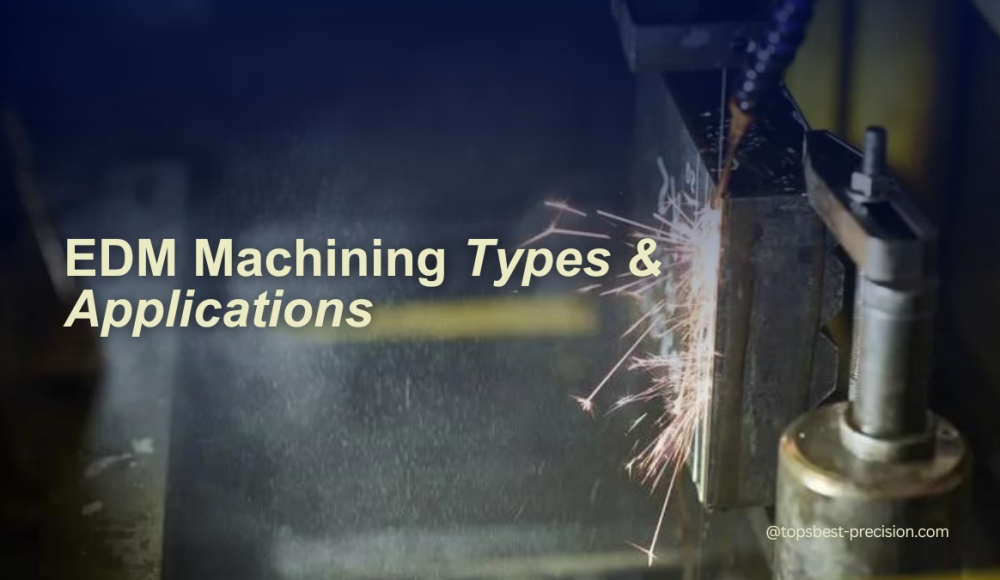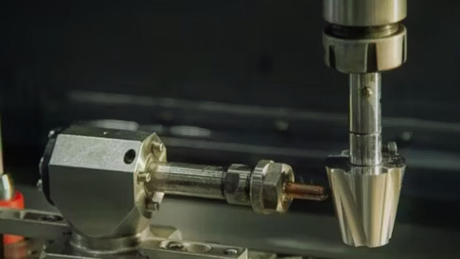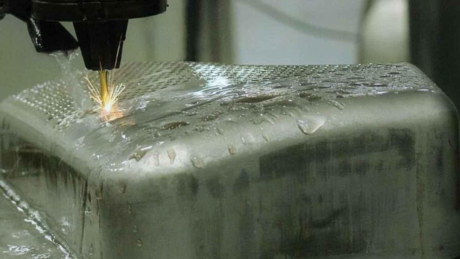Electrical Discharge Machining (EDM) is a sophisticated technique in metalworking. Typically, it falls under non-traditional material removal methods. Conventional processes like cutting, and shearing, operate by external forces, While, EDM operates by generating high-intensity electrical discharges between an electrode and a grounded workpiece. It discharges form a gap, which results in material being removed from the job-piece. EDM machining can precisely machine any electrically conductive material with minimal heat, and no residual stress. In this article, we will explain the primary types of EDM in detail. Additionally, We will provide a technical breakdown of each process and its applications.
Common Types of EDM Machining
EDM Machining includes various to precisely shape and remove material from workpieces. Each is suited for different applications.
1. Wire Electrical Discharge Machining (EDM)
Wire-cut electrical discharge machining (wire EDM) uses a thin wire as a tool to remove material by generating electrical sparks between the wire and the workpiece. As the wire moves along its path sparks cause tiny pieces of material to disintegrate. Moreover, it helps clear away debris. Initially, wire EDM was used for making 2D cuts along the x and y axes. But today, it has advanced significantly, along multiple axis. By adjusting the wire rollers, operators can now achieve angled cuts along the z-axis. The integration of rotational axes has further cultivated the process, for complex 5-axis operations.
Wire EDM is highly effective for manufacturing extrusion tools and punch-die sets. Although it doesn’t need to start holes, EDM drilling is often used to create holes for electrode insertion. Common materials for wire EDM include brass, zinc-coated brass, and copper with zinc diffusion or stratification. The choice of wire depends on the required conductivity, hardness, and tensile strength for the specific machining job.
2. Sinker Discharge Machining
Sinker discharge machining is also called ram or cavity EDM. It uses a shaped electrode to machine material by discharging sparks. The electrode, which can have simple or complex 3D shapes, is submerged into the workpiece and removes material by generating electrical discharges. To clear debris, the electrode moves slightly upward along the z-axis. While the electrodes are shaped for precision, undercuts cannot be part of the design. Copper or graphite is typically used for the electrodes, which are then crafted to match the desired cavity in hard materials.
Ram EDM is extensively in injection molding and die-casting sectors. As it allows the creation of highly detailed cavity features without machining-induced stress. This eliminates the need for post-processing requirements for surface enhancement and heat treatment.
3. Hole Drilling Electric Discharge Machining (EDM)
Hole Drilling EDM is the earliest form of electrical discharge machining (EDM). It is employed in fields like rocket gas discharge control, medical devices, and creating cooling channels in gas turbine blades. This method specializes in producing precise, small-diameter, and long straight holes. A straight electrode is used in hole-drilling EDM. The shape of the electrode’s cross-section is followed throughout the length of the hole to ensure uniformity.
The Hole Drilling process can create holes as small as 0.015 inches in diameter and larger, and it works well for both blind and through holes. The resulting holes typically have a smooth surface finish, often suitable for use as bearing surfaces without additional finishing treatments. Hole drilling EDM is especially valuable when machining challenging materials, as it allows the creation of complex shapes that would be difficult or impossible to achieve using traditional methods.
4. Laser EDM
Laser Electrical Discharge Machining (Laser EDM) is a new technology that combines Laser and Electrical Discharge Machining. It employs laser beams to create sparks that melt the conductive material, enabling designing without contact with the workpiece. Moreover, it assists in minimizing the machining tool wear hence enhancing the machining of various geometries particularly where the application is complex.
Laser EDM is accurate in the sense of the material removed with accuracy being normally within ±10 µm thus Laser EDM can be used in electronics, Aerospace, and medical industries. These features include the ability to vary laser parameters such as the pulse duration and energy density per unit area which enables high material removal rates with small HAZ. This flexibility allows the cutting of difficult materials like titanium and high-strength alloys thus making Laser EDM an important tool in fine feature generation without affecting the workpiece geometry during the machining process.
Table: Comparing Wire EDM Vs. Sinker EDM Vs. Hole Drilling EDM, and Laser EDM.
| EDM Type | Precision Values | Materials Processed | Typical Applications | Technical Factors |
| Wire Cut EDM | ±1-2 µm | Conductive metals (e.g., steel, brass) | Tooling, extrusion dies, complex parts | Wire diameter, feed rate, angle control |
| Sinker EDM | ±0.001 mm | Hard materials (e.g., tungsten carbide, graphite) | Molds, dies, intricate cavities | Electrode shape, flushing parameters |
| Hole Drilling EDM | ±0.0025 mm | Conductive materials (e.g., aluminum, copper) | Gas turbine blades, medical devices | Electrode diameter, depth control |
| Small Hole EDM | ±0.0015 mm | Hard metals (e.g., titanium, stainless steel) | Precision holes in complex assemblies | Power settings, dielectric fluid |
| Laser EDM | ±10 µm | Various conductive materials | Micro-machining, electronics components | Beam focus, pulse duration |
Application of EDM
EDM is very beneficial in several ways, ideal for use in most fields of production. Due to its accuracy, and high thermal stability, it is preferred for complex patterns.
Moreover, EDM presents economic benefits for small-scale applications such as prototype applications. If prototypes are made, manufacturers can transition to other machining methods for mass production. This flexibility makes EDM suitable for applications in sectors such as electronics, automotive, and aerospace, which require high tolerance.
1. Manufacturing of Dies, Molds & Tools
EDM is indispensable in toolmaking and die/mold manufacturing industries. It enables the creation of components that are difficult to achieve using the conventional approaches. Special tooling requires high accuracy and elaborate shapes, geometrical configurations, and structural forms with holes, slots, etc. EDM does all this efficiently.
EDM provides a very good surface finish and hence, very little or no further finishing is required. This efficiency proves helpful when saving manufacturers time and money. Well-developed industries such as aerospace and automobile industries, where weight is a major concern, EDM can deal with materials such as tungsten carbide. It also enables manufacturers to come up with long-lasting tools while at the same time maintaining quality.
2. Precision Small Hole Drilling
Another key use of EDM is in small-hole drilling, allowing holes of various shapes and depths to be made in conductive materials. The tool electrode used is slightly larger than the desired hole, ensuring a high level of accuracy. The process is particularly efficient for freeing stuck drill bits in machines, offering precise results with tolerances as low as zero. The smallest hole diameter achievable is 0.025 mm, which is difficult to attain using conventional methods, especially for such small diameters.
3. Cutting Sharp Internal Corners
Due to its non-contact nature, EDM is useful in the removal of material from corners that are hard to reach. It is capable of reaching an accuracy of +/-1 µm, even on the most challenging materials. The process can produce surface finishes of 0.1 µm RA which is significant for high-accuracy measurement in various sectors such as medical and electronics.
When used properly, wire EDM machines can make cuts as fine as the wire being used in the machine. The modern machines also provide better control over process parameters including feed rate and spark intensity. These advancements reduce previous problems that were associated with sharp corner cutting such as wire swing.
4. Engraving on Hard Materials
In particular, It’s not easy to engrave hard materials. Because the results are hardly consistent due to the metal type and the engraving force being used. In cases where the material to be cut is hard such as stainless steel then conventional methods may not suffice.
EDM thus offers a solution by using thermal and electrical energy. It makes it possible to create fine threads in hard materials without making them ductile or requiring further finishing. As long as the material is electrically conductive, EDM can engrave different difficult alloys such as Hastelloy®, Kovar®, titanium, and Nitinol. EDM is said to achieve repeatability and accuracy with the help of CNC control.
5. Removing Broken Tools from Workpieces
It’s annoying for metalworkers to come across a broken tool, stuck in a workpiece. The conventional extraction methods are destructive in most cases. Special problems are presented by such items as those that are made from highly durable materials such as hardened steel.
EDM is a safe, reliable, and clean solution. It wears the broken tool through electrical discharge in a controlled manner and forms holes until the tool breaks down. After the tool has dissolved, the fragments can be easily extracted with the help of compressed air or magnets.
In addition, it does not involve any external/mechanical cutting forces. Moreover, their precise control over the erosion process greatly minimizes the likelihood of damaging the workpiece.
Conclusion
Electrical discharge machining has continued to improve, allowing manufacturers to design sharp edges, hardened steels, blind pockets, and other small internal radii and acute angles at a faster pace. The conventional techniques of EDM have been enhanced and advanced to include non-conventional EDM techniques, and these new techniques are relatively more economical than the earlier ones.
For any of your specific requirements in machining solutions, you can count on us for a custom-made solution. EDM process is our strong side, and we welcome any questions you may have in this sphere. Contact us today for a quote and let us be your projects’ partner.








2 thoughts on “Types of EDM Machining & Their Applications”